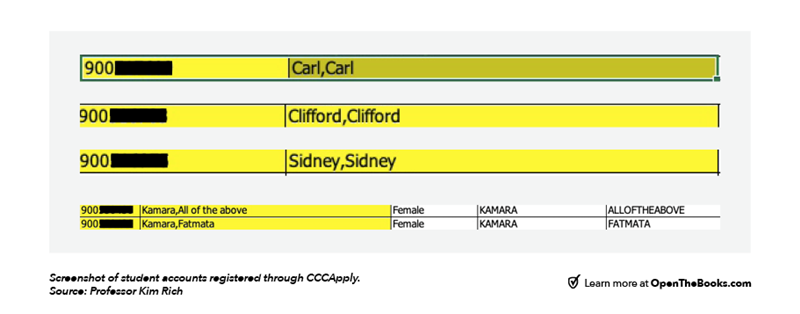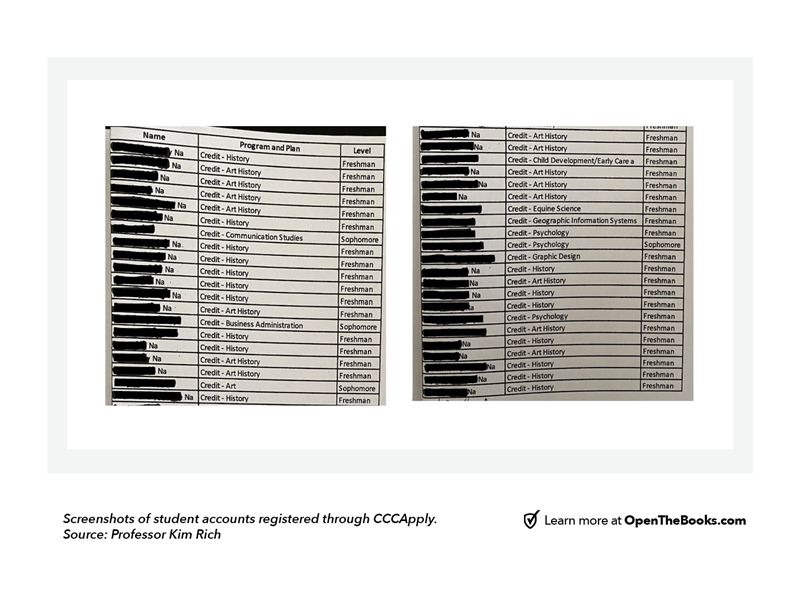



By Adam Andrzejewski
Every few days, Professor Kim Rich looks through new student registrations for the Los Angeles Community College District, including at Pierce College where she teaches criminal justice, and sees hundreds of newly created fake student enrollments.
In our conversations with Rich, she told us that It’s been going on for months.
Join OpenTheBooks on Substack!
Hackers enroll the fake students and collect up to $900 million in financial aid and Covid-19 aid each semester. However, no one seems to know for sure the sheer scale of the fraud.
These fake students, usually created by bots, open new accounts using easy-to-spot fake names like Barack Obama, Donald Trump or duplicate first names — Clifford Clifford, Jordan Jordan, Sidney Sidney, Kamara All of the above and fivethousandonehundredseven — names with questions marks or names with numbers.
New fake accounts are created, the fake students enroll in classes, taking seats away from actual students hoping to enroll in those classes. The fake accounts also “qualify” for financial aid.

Rich recently saw 1,000 new student IDs issued under five days and 386 were obviously fake, as duplicated names. There were probably many more that were fake, she said.
The average student in the junior college system gets $5,000 in federal grants.
Rich estimates conservatively that 10 percent of enrolled students — 180,000 out of the 1.8 million students at all 116 California Community Colleges — are fake. If each of those receive an average of $5,000 in financial aid, the cost is up to $900 million for a single semester.
But Rich says that’s a truly conservative estimate — most rosters she reviewed have more than 10 percent fake students. The California Community Colleges Chancellor’s Office said in August 2021 that about 20 percent of the traffic for the system-wide student application system, CCCApply, is “malicious and bot-related.”
“Even if it’s creating an .edu email account to get Apple discounts, which people do, that’s fraud,” Rich said, also speculating that some email scammers were committing financial aid fraud as well.
While she keeps an eye on this in LACCD, recording the new fake accounts as they pop up, the problem has spread like wildfire throughout California’s community college system.
Hackers aren’t hiding their efforts
In a YouTube video, a hacker named “Targetter” applies through CCCApply and walks his 70,000 viewers through the process of creating an .edu email using a bot. He shows the process of “enrolling” at one of four listed California community colleges — Contra Costa College, Mt. San Jacinto College, San Francisco City College and Sacramento City College.
He shows the bot automatically filling out a Contra Costa College application with fake personal information, and within seven minutes, he has enrolled at Contra Costa College as Ivan N. Atkinson for the fall 2020 term.
65,000 fake student enrollments – but, no one wants to clean up the books
In September 2021, the California Student Aid Commission told the LA Times “it had identified more than 65,000 applications for aid from purported community college students that appear to be fake, lending credence to the idea that scammers are seeking to get their hands on state grants.”
That month the chancellor’s office said any student accounts associated with fraudulent activity will be suspended. Last June, colleges also added bot-detection software and a new policy required colleges to confirm if applications deemed as “likely fraud” are from real students or not within two weeks.
Unless colleges confirm the applicants are actual students, the application will be automatically deemed as confirmed fraud and eliminated from the system, the LA Times reported that Valerie Lundy-Wagner, interim vice chancellor of digital innovation and infrastructure, told colleges.
But Rich said this isn’t happening.
It’s unclear whose job it is to remove these fake accounts from the college systems, Rich said. The financial aid administrators at Pierce College say it’s not their job, and professors, rightly so, also say it’s not theirs.
She believes that with schools possibly on the hook to pay back fraudulently administered financial aid, there’s no incentive to go after these fake accounts.
She compared the fraud on CCCApply to a banking system. If criminals had access to that system, the bank would simply shut down the system until it was repaired instead of allowing criminals to access millions of dollars, she argued.

Rich has found that real students have a middle name, middle initial, or it’s blank in the registration (see screenshot). The “NA” middle names were all a group that showed up on the winter rosters at once and drew her attention. Some classes had 95% of a class with “NA” as a middle name.
“These are these little anomalies that I keep running into," Rich said. "These weird patterns.”
The “NA” middle initial alone isn’t what catches her eye but it’s part of a larger puzzle. The fake students are part of the same majors, i.e. Art History or History. They are all freshmen. There are batches of sequential student ID numbers enrolled in a class.
“And that doesn’t happen, statistically that’s not very possible…This is a puzzle, you have all these pieces by themselves. When you put them together, they fit and you have the picture,” Rich said.
Our auditors at OpenTheBooks reviewed other screenshots where fake students are still signing up for classes as of May 3, 2022.
Asking for help
Rich recently sent emails to two dozen members of the California State Assembly Higher Education Committee, asking for help in investigating this but so far received no response, she said.
While the state funds community colleges based on enrollment, through the 2024-25 school year, campuses will not be financially penalized for drops in enrollment, the LA Times reported.
But Rich believes that these colleges do fear enrollment drops if they remove the fake accounts.
At her college, the institution is considered a medium college — more than 10,000 students but less than 20,000 — but if it loses students, it will be considered a small college — less than 10,000 students — and lose funding down the road, the interim VP of academic affairs recently told instructors and administrators.
“It’s a big deal to be dropped down from a medium to a small,” Rich said. “It’s mind blowing how much money they have to lose.”
Rich said administrators have focused more on ensuring that real students don’t get accidentally dropped from classes.
“The school is leaving the fake students in,” she said. “The school is afraid if they admit the fraud, they’re on the hook for allowing the fraud and having to pay it back.”
While she has raised the issue with the community college’s administrators and there have been numerous news reports about it by the Los Angeles Times, other California-based news outlets, several news outlets that cover education and national outlets, the problem persists.
Small changes aren’t stopping a big problem
The chancellor’s office has sent several memos about this issue to its colleges.
In January 2022, it alerted colleges that students were required to use multi-factor authentication that requires confirmation of an email or phone number before they can complete an application.
Paul Feist, vice chancellor for communications & marketing for the chancellor’s office, told OpenTheBooks.com that an anti-bot firewall was added in July 2021 and that coming in June 2022, there will be improved system-wide data sharing so colleges can share information with each other about fraudulent applications and students.
Also expected in June will be data-driven identity verification that creates a score showing “the likelihood of fraud based on data-profiling of attributes provided directly by the user as well as data that can be gleaned from their digital footprint,” Feist said.
Finally, sometime later in 2022 or 2023, pending legislative budgetary approval, there will be a modernization and redesign of the CCCApply system which prospective students — and bots — use to apply to the colleges, Feist said.
In June 2021, the chancellor’s office told colleges to report financial aid fraud to the U.S. Department of Education’s Office of Inspector General and “keep the Tech Center informed on the level of fraudulent activity occurring locally as it greatly improves our ability to provide needed support and respond appropriately.”
The chancellor’s office also directed all 116 community colleges to report monthly the number of incidents of suspected registration fraud, number of suspected and confirmed incidents of financial aid fraud and how much financial aid the college had to return due to fraud.
But 40 percent of the colleges haven’t submitted any information on this, the LA Times reported.
Feist said “specific metrics regarding fraud are not currently available.”
But as of April 5, 78 colleges out of 116 have responded at least once, with participation varying from 29 to 62 colleges responding in a given month, he said.
“The state Chancellor’s Office currently does not have the legal authority to require colleges to report the data we are requesting,” he said. “In May, the Board of Governors will vote on a new regulation that provides that authority, and a more comprehensive picture is expected to result from additional reporting.”
In the meantime, crooks are likely stealing real financial aid.
Join OpenTheBooks on Substack!
Bureaucracy moving slowly
The California Community Colleges system is investigating the potential fraud as a scam to collect financial aid or Covid-19 relief grants. The U.S. Department of Education’s Office of the Inspector General is investigating the scam in California and nationwide.
At the Sept. 20, 2021 CCC Board of Governors Meeting, the members discussed the issue of fake students in a closed session. On the agenda was a note from Marc LeForestier, general counsel to the Board of Governors, regarding the issue.
“Recent findings related to financial aid fraud attempts through the California Student Aid Commission are of grave concern,” he wrote.
Whistleblower retaliation?
Since Kim Rich continued to raise the issue with administrators and has spoken to the press, she has felt retaliated against for being a whistleblower.
First, after speaking to the Epoch Times for an article in November 2021, the school’s communications director reprimanded her over email for speaking directly to the press and not going through him.
In the email, he assumed there was incorrect information in the article about fake students, and asked Rich whether there was factual errors that needed correction.
The article, which quotes Rich as saying one-third of her class of 30 students were fake, needed no correction, Rich told him.
Since then, some colleagues that Rich spoke to about the fake students and other education and non-education matters, went from speaking regularly “to crickets” she said.
Rich felt she wasn’t supported in her role as department chair for political science, administration of justice, economics and Chicano studies, so she resigned six months before her three-year term was set to end.
“It wasn’t worth the stress, the frustration and aggravation,” she said.
Rich had also been working as a distance education support specialist, working to help faculty teach online during the pandemic. But her position wasn’t renewed recently without explanation.
She has spoken to a handful of colleagues who will only speak off the record about fake students because they’re afraid of retaliation, she said.
Note: A spokesperson for Los Angeles Community College District didn’t respond to a request for comment by our deadline.
About the author
Adam Andrzejewski (say: And-g-f-ski) is the CEO/founder of OpenTheBooks.com. Last year we filed 47,000 FOIA requests and captured $12 trillion in government spending (2021). Work featured at The BBC, Good Morning America; ABC World News Tonight; USA Today; The Wall Street Journal; Forbes; and The New York Times. My presentation to the Hillsdale College National Leadership seminar posted on YouTube has 3.7 million views. Learn more at OpenTheBooks.com.